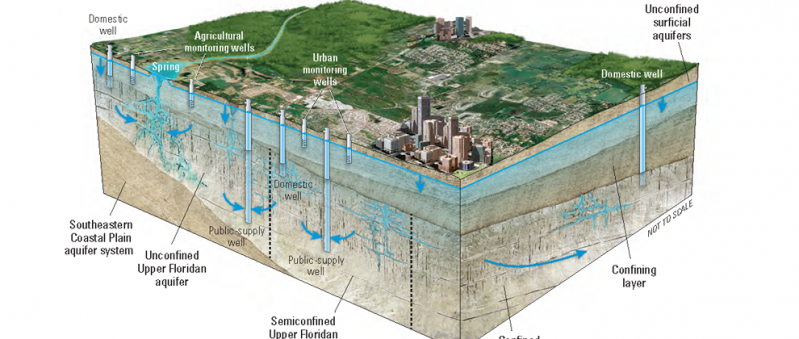Google's Controversial Groundwater Withdrawal
Published on by Water Network Research, Official research team of The Water Network in Business
Google's controversial groundwater withdrawal sparks question of who owns South Carolina water.

Google wants to tap an aquifer, a saturated layer of sediment underground, to help cool servers at its South Carolina operation in Goose Creek. Above: How an aquifer works. U.S. Geological Survey/Provided
Forty million gallons of surface water per day now are pumped to customers by the Berkeley Water and Sanitation utility. Google, the marquee computer network company, apparently uses one-tenth of it — about 4 million gallons — to cool the servers at its only South Carolina data center, in Goose Creek.
Now Google wants to draw 1.5 million gallons per day from an aquifer under the coastal region to help cool the servers after a planned expansion — a volume that would make it the third largest aquifer user in the three counties around Charleston, according to South Carolina Department of Health and Environmental Control records.
The move is opposed by residents, conservationists and nearby water utility officials. It's become the most recent water controversy to erupt in South Carolina as thirst intensifies with the demands of new industries, corporate farms and residents.
How the state decides the Google dispute has wide-ranging repercussions. Aquifers are massive, interconnected layers underground that are saturated with water that seeps from the surface over the long term. They are essentially the reserve tanks for huge spans of land across the Southeast.
Withdrawals evidently are taking out water faster than the aquifers can replenish. And no one really knows just how much water can be drawn without exhausting them.
The aquifer
The price of tap water has risen faster than gold or real estate since the 1990s, according to Datacenter Dynamics, an industry analyst. The water drawn from aquifers, on the other hand, is free. Current state regulations of aquifer use are almost non-existent.
"A lot of it is a free-for-all right now," said Emily Cedzo, the air, water and public health projects director for the Coastal Conservation League.
More than 333 million gallons of groundwater per day are now used by industries, farms and other well owners across the state, according to U.S. Geological Survey records. One billion gallons of surface water per day are used statewide.
A Google spokesman in 2008 cited the access to cheap electricity and water in South Carolina as among biggest reasons why the company chose Goose Creek for its plant. The company apparently pays about $250,000 per year for its tap water, according to a Post and Courier estimate from a report by Berkeley County Water and Sanitation.
Read full article: The Post and Courier
Media
Taxonomy
- Policy
- Resource Management
- Data Management
- Aquifer
- Consumption
- Groundwater Recharge
- Aquifer Recharge
- Governance & Planning
- Groundwater Resource
1 Comment
-
I think, it is a great idea, that Google thinks about a green way of (if) artificial groundwater recharge because it is the same old story than massive groundwater-dewatering for civil engineering. An excavation must be dug for the foundation of a building. Unfortunately, the groundwater level is too high. So well-galleries are drilled to pump down the "surface-groundwater" to dry-off the excavated-pit and led this water away into "receiving-waters" such as canals, rivers, and the sea. We can also say: poured or just dumped away ...!
This "dumped" water can, however, a) have almost drinking water qualitiy, b) also be contaminated, but not necessarily, but for sure: not controlled or just ignored. Because no-one asks.Some years ago, resourceful engineers have discovered, that this groundwater can also be pumped back into the lower-reaches of groundwater-flow of the construction project and thus keeps the entire groundwater balance: "in balance!". Thus one can advocate such a Google cooling water by groundwater use also without hesitation. You can even extract energy from the cold and also from the heated process water and even use it for groundwater treatment, in case, somebody dicoveres, that other industries have dumped their garbage and contaminated the said water before...
So: Be Innovative! Don't belong anymore to copy/paste- & laptop-engineering
Google Go..!